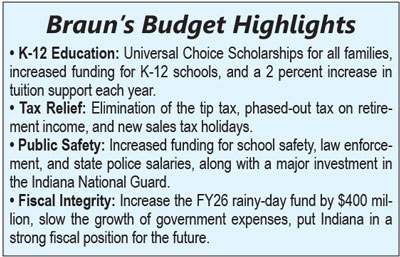By GARRETT BERGQUIST
WISH-TV | wishtv.com
Gov. Mike Braun on Thursday said he plans to continue Indiana’s recent track record on government spending with a business-minded approach.

Braun
Not quite 72 hours after taking the oath of office, Braun unveiled his first two-year budget Thursday morning. It includes a 2 percent increase in basic public school funding for the 2026 budget year followed by another such increase for the 2027 budget year. It also removes all remaining limits on eligibility for School Choice vouchers. Minimum teacher salaries would rise to $45,000 per year, up from the current $40,000. In addition, Education Scholarship Accounts, which help students with disabilities pay for programs and services, would get an extra $30 million.
On health care, Braun’s plan would set aside $362 million to eliminate the waitlist for Indiana Child Care Development Fund vouchers, which pay for child care for families making less than 150 percent of the federal poverty line. It also fully funds the state’s Medicaid forecast. That means $680 million for the 2026 budget year and $1 billion for the 2027 budget year.
In addition, the plan incorporates his property tax cuts and elimination of taxes on retirement income. Braun said at a minimum, he wants caps going forward on how much property taxes can rise in a given year.
Braun’s budget depends in part on his goal of a 5 percent across-the-board reduction in the state’s operational and administrative expenses by the end of the 2027 budget year. State Budget Director Chad Ranney later told the State Budget Committee that would work out to about $700 million in savings. Braun said those savings could be used either to bolster spending for state services or to offset revenue lost to tax cuts.
“We’re not just looking in one area, we’re looking across the board, and we’re going to have each cabinet secretary find where that’s going to be in their own domain and that’s going to be something we flesh out over the next three months,” Braun said.
Braun further clarified some agencies might not be able to make as deep cuts in others and it would be up to the cabinet to figure out those numbers.
Two potential clouds hang over the budget: an expected slowdown in state revenue growth in 2027 and possible federal spending cuts by the incoming Trump administration. Two state representatives serving on the State Budget Committee, Democrat Ed DeLaney of Indianapolis and Republican Craig Snow of Warsaw, said the Braun administration would have to be prepared to respond to those spending cuts, possibly by using some of the state’s financial reserves.
 “Depending on the program, we get between 70 percent and 90 percent support from Washington,” DeLaney told Ranney at the end of an early afternoon budget briefing. “If they cut it, or if they got this block grant system, I hope you’ll be prepared, as some of that could happen before we’re out of here at the end of April. We might pass the budget in March and then find ourselves undercut.”
“Depending on the program, we get between 70 percent and 90 percent support from Washington,” DeLaney told Ranney at the end of an early afternoon budget briefing. “If they cut it, or if they got this block grant system, I hope you’ll be prepared, as some of that could happen before we’re out of here at the end of April. We might pass the budget in March and then find ourselves undercut.”
So far, Braun has played a hands-on role in the budget negotiations. He said he met with House Speaker Todd Huston and Senate President pro tem Rod Bray, both fellow Republicans, earlier this week to go over budget details and his property tax plan, which is currently in the Senate as Senate Bill 1. Huston has said the Senate will focus on property taxes during the first half of session while the House concentrates on the budget.
It will be up to the House Ways and Means Committee to work on the budget over the next month. The House has until Feb. 20 to send the budget bill to the Senate.
This story was originally published by WISH-TV at wishtv.com/news/braun-budget-find-more-efficiencies-eliminate-child-care-waitlist.

